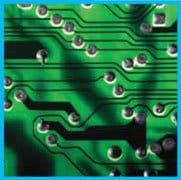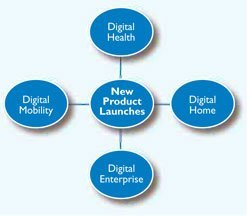
Nearly everyone is aware of Intel. It is the world’s fifth most valuable brand valued at around $35 billion. Most of the world’s personal computers are driven by Intel microprocessors.
By concentrating on producing great microprocessors Intel was able to leave its competitors behind. The company invested billions of dollars in highly productive manufacturing plants that could produce more processors in a day than some of their rivals could produce in a year.
Today Intel is continuing to raise the bar. In January 2006 the company launched its new strategy based on identifying and creating new markets. Instead of just focusing on personal computers (PCs) Intel will play a key technological role in a range of fields including consumer electronics, wireless communications and healthcare.
Intel has been one of the world’s high achieving businesses. Its global appeal is not surprising. In recent years almost every time you opened up a laptop you would see that it was labelled ‘Intel® Inside’. Seeing this, the user knew that they had a high performing and reliable computer.
We all want to be able to use more powerful technology, which is simple to operate, and helps us to do things without having to think about it. However, Intel has moved on. The problem with simply being a producer of processors is that other firms can move into your market. Once they produce similar products the only way you can differentiate is by offering lower prices.
Intel’s new strategy is to create lots of different types of chips and software and then combine them together into platforms. A platform is an integrated set of proven technologies designed to work together. They provide people and businesses with improved communications and computing capabilities. These platforms will enable Intel to bring added value for consumers, win a larger share of consumer expenditure and increase revenue.
Platforms will make life easier for people in a range of settings from the home, to business, and medical settings. Intel’s vision involves giving people access to easy-to-use technologies through these platforms. It is seeking to continually satisfy customer requirements by producing a range of new and exciting products.
Developing a new strategy

Organisations live or die as a result of the strategies they choose. A business strategy is a plan for the whole organisation. The strategy must fit with the business environment – the changing world in which the business exists.
Intel has been at the centre of a growing industry for over thirty years. However, the growth in the sales of personal computers is slowing down in a very competitive environment. In addition, mobile phones and hand held devices have become increasingly important alternatives.
Since 2003 Intel’s sales revenue has grown by an average of 13% a year. However, as the market segment matures, laptop sales are growing whilst desktop sales are slowing down. As a result Intel generated record revenues of $38.8 billion in 2005.
Intel is an ‘ingredient brand’. Its products and processors form part of the products that consumers purchase. Building key relationships with leading electronic firms such as Sony and Philips is an important strategy. The aim is to provide the manufacturers of products such as laptops, mobile phones and entertainment personal computers with integrated packages of chips and software – in other words a complete solution.
A key part of Intel’s more integrated platform strategy involves the development of several technologies. These improve processor efficiency and allow computer users to take better advantage of:
- multi-tasking
- security
- reliability
- manageability
- wireless computing capabilities.
Understanding how people actually use technology and then driving the power of Moore’s Law to deliver increased capabilities, means that end users obtain more benefits and increased usefulness from the technology.
Systems are continually updated giving the user greater freedom. Intel’s strategy is to be at the heart of new developments in home entertainment, security, medical care, etc. Its new strategy is about:
- working with customers to share a vision of future technologies
- developing new customer focused technologies
- giving people new products that are easy to understand and use
- communicating clear messages about these new products.
Launching a new strategy
When an organisation changes, it is important to communicate the nature of that change so that everyone knows about it. Typically, this means:
- externally to customers, partners, suppliers, the media, etc
- internally to staff.
On January 5th, 2006 Intel launched its new strategy at the Consumer Electronics Show in Las Vegas.

The high-profile launch featured the hip-hop band Black Eyed Peas, with the hit single ‘Let’s get it started’. A key part was the unveiling of a new corporate logo. A logo is a visual representation of what a company stands for. The new logo sets out clearly that Intel is moving forward. The swirl around it signifies movement. The strapline ‘Intel.Leap aheadTM’ has been introduced. The launch was backed by a multi-million dollar advertising and marketing campaign.
Today Intel’s communication messages show it is at the leading edge of technology. Intel’s marketing focus is on helping consumers to understand in a clear way how new technologies can help them to live better lives.
Intel’s values are straightforward, they involve:
- being prepared to take risks
- operating in a disciplined way
- focusing on achieving great results e.g. high performance, sales, and profits.
Great results are achieved through developing the right products for the right markets before competitors do so.
Developing new products

In our fast changing modern world, it is essential to find out what consumers want and need. It is possible to predict trends and developments. Because Intel is at the leading edge of technological developments it is well placed to anticipate consumer requirements.
In addition, it uses customer focus groups to find out what they think of the scenarios for the future that Intel anticipates e.g. lifestyle developments. A focus group consists of a relatively small number of consumers representing a market segment Intel is targeting.
For example, lifestyle trendsetters who are very knowledgeable about home entertainment developments or medical professionals interested in improving patient record systems. There is also huge scope for intelligent organisations like Intel to increase their presence in the health industry. This industry has been slow in adopting IT applications because healthcare primarily involves person to person contacts. However, health professionals are increasingly recognising the benefits of IT.
New product development to meet anticipated needs involves a considerable outlay of capital e.g. building new factories to build the products of the future. Being market focused therefore lies at the heart of Intel’s success and direction. Intel’s digital home division is part of the Digital Living Network Alliance, an alliance of over 250 companies. Their aim is to create joint standards, improve interoperability and ease of use between different products in the home. Intel was one of the key founders and still sits on the Board of Directors.
In 2006 Intel is rolling out a series of new products reflecting its innovative strategic approach.
Examples include:
- Intel® ViivTM technology – a home entertainment platform.
- Intel® Centrino® Duo mobile technology – a dual core processor notebook platform.
- Intel® ViivTM technology is a new home entertainment platform. ViivTM rhymes with five. It can play/pause TV, download films, music and games, and will develop to enable easier movement of content around the home.
Restructuring Intel around its market
Intel built its early success on providing ingredients for personal computers with its prime driver being technology. It was dominated by engineers and worked closely with Microsoft and PC manufacturers such as Dell, Compaq and IBM.
The new strategycontinues the emphasis on producing excellent products. However, there is now a strong focus on marketing- finding out what customers want and then meeting their requirements. Customers need to know what these new products can do for them. Clear communication is therefore essential.
The company has been restructured from top to bottom affecting over 90,000 employees. The emphasis is on marketing and communicating with customers about what the new technologies can do for them. In the words of the new Chief Executive Officer: ‘To sell technology now you have to do it in a way which is much more simple. You can’t talk about the bits and the bytes’. In other words it is about what people make possible with Intel products.

Today Intel is working with a broad range of fellow travellers e.g. with Motorola for mobile devices and with hospitals for digital health.
The market for high-tech products and systems is broken up into discrete segments. Intel recognises this and has therefore created four divisions representing these segments.

Although different target groups have common needs for information, the types of information they want at home or work will be different. For example, a recording of a romantic movie or thriller is watched at home whilst at work it will be a trainingvideo or video conferencing facility. Digital home is committed to providing the ultimate entertainment experience, whilst digital health will work directly with hospitals and health care professionals.
New product development focuses on specific markets. For example, in hospitals paper records are replaced with electronic tablets giving immediate access to patient records, appropriate drug prescriptions etc.
In business Intel has developed a range of chips for personal organisers, servers and a range of other applications. In mobility it has provided the processing applications that drive new products for people who want to keep in touch whilst on the move.
Within product divisions there is a strong emphasis on team building to share expertise. Chip engineers, software developers, marketers, and market specialists work to develop new and exciting products.
Conclusion

Intel is one of the success stories of the high-tech world. It provides vital components for personal computing. Now the company is moving forward into a range of new and exciting products and markets with a much stronger focus on marketing.
